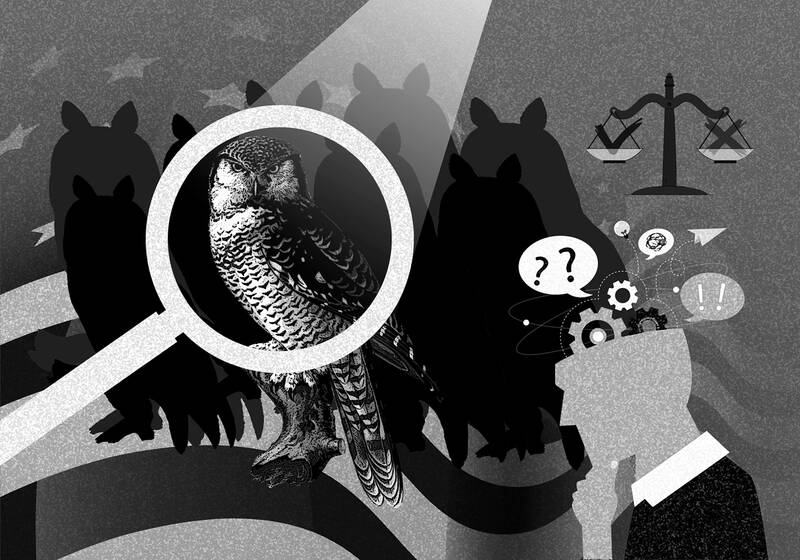It is routine practice for government officials to kill animals deemed invasive or destructive. For the most part, Americans accept this or look the other way — especially if the “pests” are insects, rodents or garden-munching deer. That has changed now that the US Fish and Wildlife Service plans to shoot thousands of owls in California, Oregon and Washington.
The species on the hit list is the barred owl — a creature whose adaptability has enabled it to spread into new areas. This expansion is driving the increasingly rare spotted owl to extinction.
This is not just natural selection in action. All over the world, human activity has changed landscapes so fast that the diversity of plants and animals is collapsing — with a few hardy species taking over. In an attempt to stop this, authorities around the world are protecting coral reefs by killing starfish, protecting salmon by killing sea lions and protecting red squirrels by killing gray ones.

Illustration: Louise Ting
However, the case of the spotted owl is unusual because, to the untrained eye, it almost looks the same as a barred owl. The two species are so closely related, they sometimes mate and produce hybrid offspring. That has forced a reconsideration of big ethical questions: Is it moral to kill in the name of ecological balance and diversity? If it can be, how do we decide which species are acceptable to target?
Field experiments show that shooting barred owls can stave off the decline of the spotted owl, but there is no end point. The current plan under the Fish and Wildlife Service would go on for 30 years and kill up to half a million owls. However, it is understood that the shooting would have to go on forever to save the spotted owl.
Stephen Pruett-Jones, an ecologist at the University of Chicago, said that while barred owls can interbreed with spotted owls, they are very different animals with different calls and different diets.
Spotted owls only eat certain small mammals, while barred owls can eat mammals, fish, amphibians, birds, insects and slugs. Spotted owls are only adapted to live in old-growth forests; barred owls live in a much wider range of environments.
In the 1980s and 1990s, environmentalists used the spotted owl’s status under the Endangered Species Act to argue that a fraction of the old-growth forest in the Pacific Northwest should be protected from logging. They succeeded, but the spotted owls continued to decline — losing 80 percent of their numbers in the past 30 years.
Scientists and bird watchers witnessed the bigger, more aggressive barred owl move in and outcompete spotted owls for food and nesting sites. It is not just the spotted owl that is at risk — the barred owl’s proliferation might be hurting the local screech owl and pygmy owl populations. Some scientists worry that human activity has depleted the spotted owl populations and accelerated the barred owl’s expansion.
Kent Livezey, a retired wildlife biologist for the Fish and Wildlife Service said that human activity has affected owl ranges for millennia, starting when Native Americans used fire to clear land in the middle of the continent. As European colonists took over, suppressing fires and building farms, towns and parks, they helped create a corridor of trees through which barred owls slowly expanded westward along with many other birds.
Livezey said he is not opposed to killing a few barred owls in places where spotted owls can be saved. His concern is that the government plan includes culling in areas surrounded by thousands of barred owls, so more would move in replacing any that are shot.
He worries the killing is being motivated by another reason — under the Endangered Species Act, the spotted owl is the only legal leverage preventing logging from destroying what is left of the old-growth forests. It would be far better to create new laws to protect the forests rather than kill thousands of owls.
The one place where he thinks there is hope for the spotted owl is in the Sierra Nevada mountains. In other places, he said, the shooting would be a waste of money and of avian life.
A recent New York Times op-ed piece also argues against the killing, citing “genomic evidence that the barred owl has in fact resided in the Pacific Northwest for thousands of years.” However, that was at odds with what all the scientists told me. The paper cited did not appear to make that case, so I called one of the authors, biodiversity scientist John Dumbacher.
He said the Times piece misrepresents his work, which shows there is more genetic variation among barred owl populations than thought.
“The data are clear at this point: The barred owl is an existential threat to the spotted owl,” he said.
The spotted owl is “disappearing at a rate that’s blowing away the scientists,” he said.
If humans had not drastically depleted their numbers by destroying much of the old-growth forest they depend on to survive, maybe they would have stood up better to the barred owls.
“The science is all very clear about what’s going on, but the science doesn’t tell you what to do about it,” Dumbacher said.
For that, we need ethical arguments. The public should have a say as well.
He said he has given public lectures on this issue and people have mixed views. He understands people’s opposition to killing charismatic creatures. He is not opposed to taking either road, but either choice would have consequences.
If we do nothing, it is all going to be dandelions and raccoons and black rats — and a few other species that can adapt to human-degraded environments, he said.
There might be no good path forward. What might be more important is proceeding wisely — having an end goal, learning from mistakes, and doing what we can to avoid coming to this juncture in the future.
F.D. Flam is a Bloomberg Opinion columnist covering science. She is host of the Follow the Science podcast. This column does not necessarily reflect the opinion of the editorial board or Bloomberg LP and its owners.

As strategic tensions escalate across the vast Indo-Pacific region, Taiwan has emerged as more than a potential flashpoint. It is the fulcrum upon which the credibility of the evolving American-led strategy of integrated deterrence now rests. How the US and regional powers like Japan respond to Taiwan’s defense, and how credible the deterrent against Chinese aggression proves to be, will profoundly shape the Indo-Pacific security architecture for years to come. A successful defense of Taiwan through strengthened deterrence in the Indo-Pacific would enhance the credibility of the US-led alliance system and underpin America’s global preeminence, while a failure of integrated deterrence would
It is being said every second day: The ongoing recall campaign in Taiwan — where citizens are trying to collect enough signatures to trigger re-elections for a number of Chinese Nationalist Party (KMT) legislators — is orchestrated by the Democratic Progressive Party (DPP), or even President William Lai (賴清德) himself. The KMT makes the claim, and foreign media and analysts repeat it. However, they never show any proof — because there is not any. It is alarming how easily academics, journalists and experts toss around claims that amount to accusing a democratic government of conspiracy — without a shred of evidence. These
US President Donald Trump created some consternation in Taiwan last week when he told a news conference that a successful trade deal with China would help with “unification.” Although the People’s Republic of China has never ruled Taiwan, Trump’s language struck a raw nerve in Taiwan given his open siding with Russian President Vladimir Putin’s aggression seeking to “reunify” Ukraine and Russia. On earlier occasions, Trump has criticized Taiwan for “stealing” the US’ chip industry and for relying too much on the US for defense, ominously presaging a weakening of US support for Taiwan. However, further examination of Trump’s remarks in
Taiwan is confronting escalating threats from its behemoth neighbor. Last month, the Chinese People’s Liberation Army conducted live-fire drills in the East China Sea, practicing blockades and precision strikes on simulated targets, while its escalating cyberattacks targeting government, financial and telecommunication systems threaten to disrupt Taiwan’s digital infrastructure. The mounting geopolitical pressure underscores Taiwan’s need to strengthen its defense capabilities to deter possible aggression and improve civilian preparedness. The consequences of inadequate preparation have been made all too clear by the tragic situation in Ukraine. Taiwan can build on its successful COVID-19 response, marked by effective planning and execution, to enhance